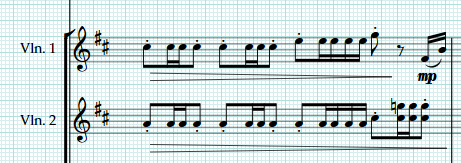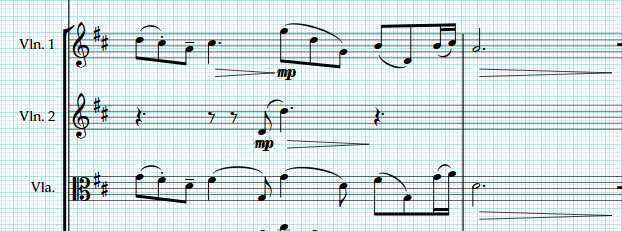Creating nice sheet music from GBA soundtracks, part 3
Back at it! I thought I’d finish this tonight but it turns out what I originally estimated would be part 3 is actually going to be parts three and four. Tonight’s work was mostly on the audio, next time will concentrate on the last bits of the visual stuff.
So after making it look somewhat nice, the next thing to do is go through each part and put in some articulation. There are different things to consider for different instruments: winds need breaths here and there while strings can play long phrases; woodwinds can do long slurs, but on string instruments a slur normally means play in a single bow, so theirs have to be shorter. So in places where we have two parts playing the same tune, there will nonetheless be subtle differences, like this:

I did a bit of playing around with the distribution of parts, for the sake of balance: took some of the top Gs out of the flute, as they stood out a bit too much, and then moved a lot of the second violin stuff into a new viola part to make it sound less harsh in the lower register. This also solved an issue I had at the end of the middle section where the violin parts had to switch from one role to another with a bit of overlap: now the second violins can cover the end of one section while the first violins and violas move on to the beginning of the next one.

After adding some articulations to the melody, I checked them against the real thing. This is also a good point to fill in dynamics, but really, apart from the ends of phrases tapering off, there aren’t that many of those here.
Then I looked at the various parts sharing the bassline; the main thing that came up was that the bassoon part needed an extra note added to the end of the phrases to finish them off completely, instead of just having a nonuplet that segues abruptly into nothing.

Then the harp part: most of this was just distributing stuff across the staves, treble notes in the treble, bass notes in the bass. The switch to the middle section illustrates this nicely (the dynamics are wrongly aligned here but we’ll fix that later).

For the drum kit, I ended up putting the echo back in on the snare after listening to the original again. There are various ways of writing out drum parts but I went for my usual “hands in voice 1, feet in voice 2” option, and added the kick to the accented snare beats to give them a bit more body (and to make the music easier to read – and I also lengthened some of the note values to help with this, which is a special advantage of drum parts).

After all this stuff, the next thing is to do the dynamics more thoroughly, mostly for the sake of balance. At this point I ended up redistributing the upper strings in places to give some of the higher viola notes to the second violins, just so they have a bit more power, and this also gives the second violins something to do (i.e. a single note to play) during what would have been very long rests.

Once that distraction was over, back to the dynamics … as I said, there aren’t many of them in this, but I put a few crescendi and diminuendi in the middle section just to highlight the natural contours of the phrases and to make it a bit more interesting.
In audio terms, we now have the finished product:
Visually, there are still a few things to sort out, which I’ll leave for part four.

